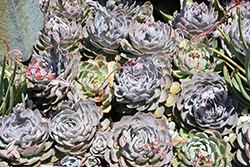It's all about ...
plants

Blue Heron Echeveria
Echeveria 'Blue Heron'
Plant Height: 5 inches
Flower Height: 12 inches
Spread: 18 inches
Sunlight:
![]()
![]()
Hardiness Zone: 9b
Other Names: Hens And Chicks
Description:
This succulent variety is very drought tolerant, producing rosettes of ruffled, pale green leaves that flush with iceberg blue, pink, mauve, and cream; distinctive reddish flowers appear on tall stems from late spring; ideal for containers, indoors or out
Ornamental Features
Blue Heron Echeveria features unusual spikes of orange tubular flowers with shell pink overtones rising above the foliage from late spring to mid summer, which emerge from distinctive pink flower buds. Its attractive succulent oval leaves remain bluish-green in colour with showy powder blue variegation and tinges of pink throughout the year.
Landscape Attributes
Blue Heron Echeveria is a dense herbaceous evergreen perennial with tall flower stalks held atop a low mound of foliage. Its relatively fine texture sets it apart from other garden plants with less refined foliage.
This plant will require occasional maintenance and upkeep, and should not require much pruning, except when necessary, such as to remove dieback. Deer don't particularly care for this plant and will usually leave it alone in favor of tastier treats. Gardeners should be aware of the following characteristic(s) that may warrant special consideration;
- Spreading
Blue Heron Echeveria is recommended for the following landscape applications;
- Accent
- Mass Planting
- Rock/Alpine Gardens
- General Garden Use
- Container Planting
Planting & Growing
Blue Heron Echeveria will grow to be only 5 inches tall at maturity extending to 12 inches tall with the flowers, with a spread of 18 inches. Its foliage tends to remain low and dense right to the ground. It grows at a medium rate, and under ideal conditions can be expected to live for approximately 20 years. As an evegreen perennial, this plant will typically keep its form and foliage year-round.
This plant does best in full sun to partial shade. It prefers dry to average moisture levels with very well-drained soil, and will often die in standing water. It is considered to be drought-tolerant, and thus makes an ideal choice for a low-water garden or xeriscape application. This plant should not require much in the way of fertilizing once established, although it may appreciate a shot of general-purpose fertilizer from time to time early in the growing season. It is not particular as to soil pH, but grows best in sandy soils. It is highly tolerant of urban pollution and will even thrive in inner city environments. This particular variety is an interspecific hybrid. It can be propagated by division; however, as a cultivated variety, be aware that it may be subject to certain restrictions or prohibitions on propagation.
Blue Heron Echeveria is a fine choice for the garden, but it is also a good selection for planting in outdoor pots and containers. It is often used as a 'filler' in the 'spiller-thriller-filler' container combination, providing a mass of flowers and foliage against which the larger thriller plants stand out. Note that when growing plants in outdoor containers and baskets, they may require more frequent waterings than they would in the yard or garden. Be aware that in our climate, most plants cannot be expected to survive the winter if left in containers outdoors, and this plant is no exception. Contact our experts for more information on how to protect it over the winter months.
This plant is not reliably hardy in our region, and certain restrictions may apply; contact the store for more information.
